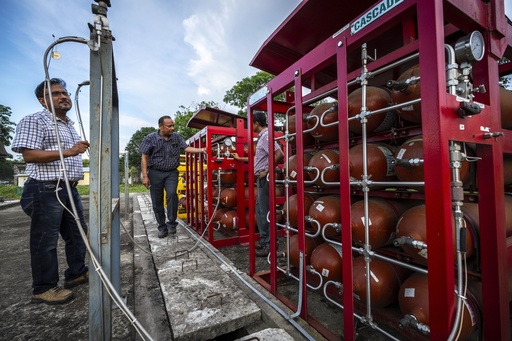What is green hydrogen and why is it touted as a clean fuel?

P V R Murthy, center, general manager at Oil India Limited, pump station 3, shows a part of a hydrogen plant in Jorhat, India, Thursday, Aug. 17, 2023. AP
BENGALURU, India — Green hydrogen is being touted around the world as a clean energy solution to take the carbon out of high-emitting sectors like transport and industrial manufacturing.
The India-led International Solar Alliance launched the Green Hydrogen Innovation Centre earlier this year, and India itself approved $2.3 billion for the production, use and export of green hydrogen. Global cooperation on green hydrogen manufacturing and supply is expected to be discussed by G-20 leaders at this week’s summit in New Delhi.
What is green hydrogen?
Hydrogen is produced by separating that element from others in molecules where hydrogen occurs. For example, water — well known by its chemical symbol of H20, or two hydrogen atoms and one oxygen atom — can be split into those component atoms through electrolysis.
Hydrogen has been produced and used at scale for over a century, primarily to make fertilizers and plastics and to refine oil. It has mostly been produced using fossil fuels, especially natural gas.
But when the production is powered by renewable energy, the resulting hydrogen is green hydrogen.
Article continues after this advertisementThe global market for green hydrogen is expected to reach $410 billion by 2030, according to analysts, which would more than double its current market size.
Article continues after this advertisementHowever, critics say the fuel is not always viable at scale and its ‘green’ credentials are determined by the source of energy used to produce it.
What can green hydrogen be used for?
Green hydrogen can have a variety of uses in industries such as steelmaking, concrete production and manufacturing chemicals and fertilizers. It can also be used to generate electricity, as a fuel for transport and to heat homes and offices. Today, hydrogen is primarily used in refining petrol and manufacturing fertilizers. While petrol would have no use in a fossil fuel-free world, emissions from making fertilizer — essential to grow crops that feed the world — can be reduced by using green hydrogen.
Francisco Boshell, an energy analyst at the International Renewable Energy Agency in Abu Dhabi, is optimistic about green hydrogen’s role in the transition to clean energy, especially in cases where energy from renewables like solar and wind can’t practically be stored and used via battery — like aviation, shipping and some industrial processes.
He said hydrogen’s volatility — it’s highly flammable and requires special pipelines for safe transport — means most green hydrogen will likely be used close to where it is made.
Are there doubts about green hydrogen?
That flammability plus transport issues limit hydrogen’s use in “dispersed applications” such as residential heating, according to a report by the Energy Transitions Commission, a coalition of energy leaders committed to net-zero emissions by 2050. It also is less efficient than direct electrification as some energy is lost when renewables are converted to hydrogen and then the hydrogen is converted again to power, the report said.
That report noted strong potential for hydrogen as an alternative to batteries for energy storage at large scale and for long periods.
Other studies have questioned the high cost of production, investment risks, greater need for water than other clean power and the lack of international standards that hinders a global market.
Robert Howarth, a professor of ecology and environmental biology at Cornell University in Ithaca, New York, who also sits on New York’s Climate Action Council, said green hydrogen is being oversold in part due to lobbying by the oil and gas industry.
Boshell, of the International Renewable Energy Agency, disagreed. His organization has projected hydrogen demand will grow to 550 million tons by 2050, up from the current 100 million tons.
The International Energy Agency says production of hydrogen is responsible for around 830 million tons of carbon dioxide per year. Boshell said just replacing this so-called gray hydrogen — hydrogen produced from fossil fuels — would ensure a long-term market for green hydrogen.
“The first thing we have to do is start replacing the existing demand for gray hydrogen. And then we can add additional demand and applications of green hydrogen as a fuel for industries, shipping and aviation,” he said.
RELATED STORIES